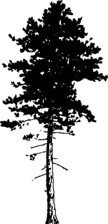|
SILVICS OF RED PINE
(Pinus resinosa Ait.)
Common names:
- Norway pine, bull pine
Field identification aids:
- has the longest needles of pines with two needles per cluster
- needles break in two when bent
- bark on older trees breaks off in flat red-brown plates
Average mature tree:
- 60 to 70 years old
- 18 m to 25 m (60' to 80') tall
- 30 cm to 60 cm (12" to 24") in diameter at breast height
Maximum life span:
- 200 years
Shade Tolerance:
- intolerant
Rooting:
- moderately deep and wide-spreading
Windfirmness:
- moderate to good depending on soil depth
Reproduction:
- reproduces by seed
- tree may begin to produce seed at 20 with full production after 50 years
- good seed crop every 3-7 years, with a bumper crop every 10-12 years
- germination best on moist humus mineral mixture
- poor germination on heavy litter
Growing sites:
- will grow on soils too poor for white pine
- best growth is on well-drained sandy soils
Associated species:
- white pine and jack pine
- occasionally grows in pure stands
Principal damaging agents:
- Sirococcus shoot blight, European pine shoot moth
- prone to mechanical breakage and browsing from white tail deer
Notes:
- red pine comprises less than 0.5% of the merchantable volume in Nova Scotia
- sturdy, rot resistant wood makes it ideal for power poles and wharf and bridge pilings
|


